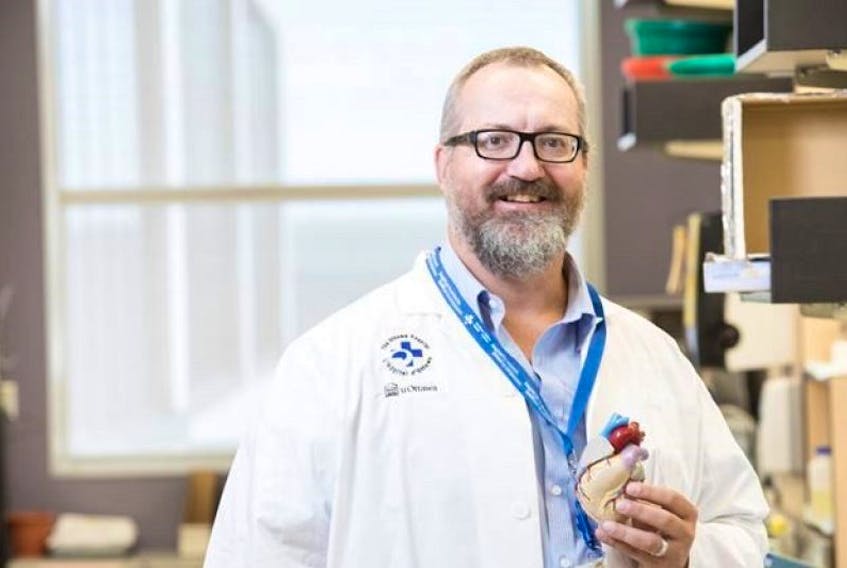Lynn Megeney, born and raised in Stellarton, is one of several scientists at the cusp of a breakthrough in the science behind treating heart disease.
Megeney, a senior scientist at the Ottawa Hospital Research Institute and professor in the Department of Medicine at the University of Ottawa, has been working to uncover the regenerative potential of a particular heart protein called cardiotrophin 1 (CT-1).
“We’ve known for a long time, that there are many benefits to be derived from regular exercise for the heart,” said Megeney. “The heart adapts in a specific way to regular patterns of activity and exercise. It gets bigger and thicker, and the blood supply dramatically improves its ability to work as a pump improves with exercise.”
Megeney and his fellow scientists have been able to determine that CT-1 plays an important role in the process of strengthening a heart. In his research, Megeney discovered that the same protein that helps endurance athletes’ hearts grow stronger from regular training is the same one that causes a pregnant woman’s heart to grow in size and strength as her pregnancy progresses.
“It’s quite remarkable – a woman who delivers a baby has a heart mass that increases 30 to 35 per cent. The interesting thing about that type of change in the heart is that it is fully reversible,” Megeney said. “If someone stops training, their heart will return to normal dimensions and a pregnant woman’s heart will be back to its normal size, three to four months after having a baby.”
Megeney said that was a premise of over a decade of research he and his colleagues did – finding out how proteins and genes factor into that changing heart size, since that “raises the possibility that something is going on, that drives this positive change.”
Much of the work has been finding factors to use in situations where the heart is not working well, to bring it back to a more functional state.
“We want to figure out how to incorporate the beneficial sorts of changes of CT-1, like making the heart and cells bigger, and improving the blood supply,” said Megeney.
This couldn’t come at a better time, since heart disease – particularly right heart failure, a condition for which very few treatment options exist – is on the rise in the developed world, particularly North America.
“There’s a division in the patient population right now. We became good at treating congestive heart failure. Those patients get drugs that put the brakes on progression of heart failure – we’re good at managing that kind of heart failure,” said Megeney.
Right heart failure, on the other hand, is a different story. About 45 to 50 per cent of patients diagnosed with heart failure suffer from right heart failure – a condition that the litany of drugs available for congestive heart failure are ineffective at treating.
“What we saw with cardiotrophin is that it can beneficially remodel the right side of the heart, like pregnant women’s and athletes’ hearts. Cardiotrophin is effective in reproducing the effect of exercise in patients,” said Megeney. “It could put the brakes on something like right heart failure, and stop it right in its tracks.”
This is necessary, Megeney said, because other medical interventions, short of a heart transplant, don’t work at treating right heart failure. And with between 100,000 and 300,000 patients suffering from right heart failure, per year in North America, the problem continues to grow – especially as the population continues to age.
“There are a lot of factors. We don’t understand all of them yet, but the only intervention patients have as an option right now is a heart transplant. There aren’t 100,000 to 300,000 hearts available for transplant, so it’s a huge medical need to treat the issue.”
At this stage, Megeney said he is occupied working on pre-clinical trials on mice and rats – and those trials are going well. Doses of human CT-1 have been demonstrated to “put the brakes on” right heart failure.
The fact that trials involve the human protein being used on animals gives Megeney and his colleagues “a leg up in development of this for patient populations.”
He added, “We took a gamble early on and immediately developed a large supply of the human protein, and started using that on the animals right away.”
Megeney said the next step is to develop the first clinical trials of using CT-1 in human patients – something he hopes to see happening within three years.
“Typically, the discovery-to-trial is a minimum of six to 10 years before something reaches the patient population,” he said. “But with the way we conducted the experiments by using the human protein, and the fact that (right heart failure patients) have no other options, we’re looking at starting clinical trials in three years.”
Megeney took his undergraduate studies at St. Francis Xavier University and started working on his PhD at Dalhousie, finishing study at the University of Waterloo. He then went on to do extensive post doctorate training in molecular biology at McMaster University. He and his family regularly visit Pictou County.









